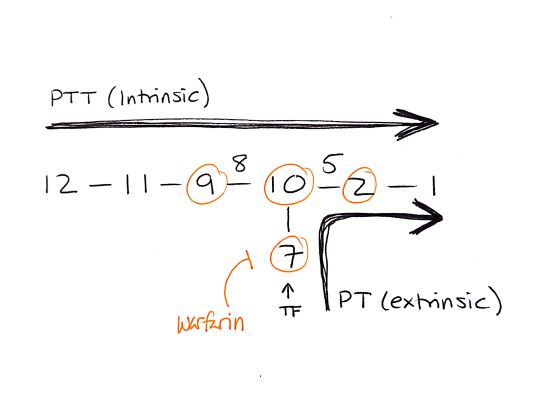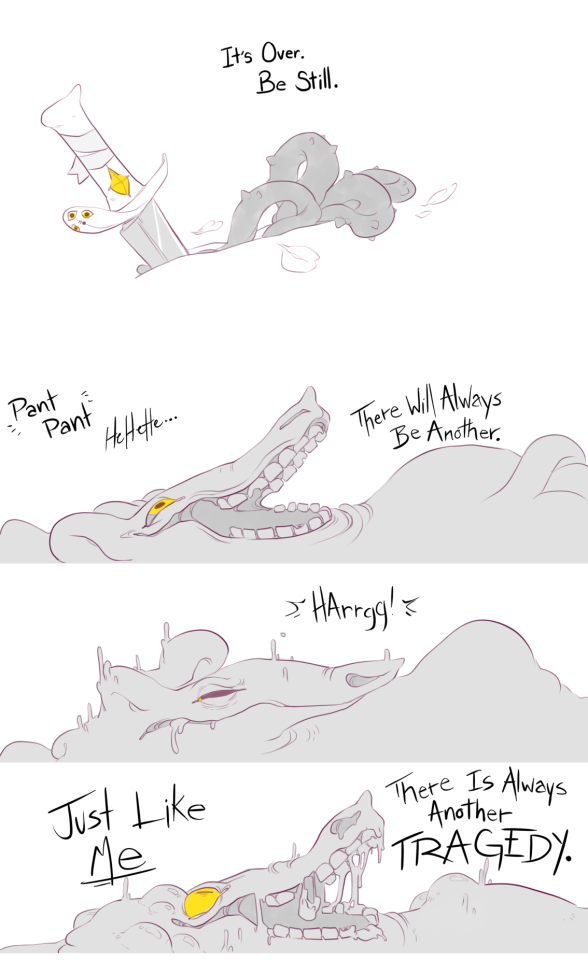Video
Hyperkalaemia ECG changes in 15 seconds.
High levels of potassium destabilise the cardiac membrane causing arrhythmia’s which lead to cardiac arrest. This can be a real life-saving opportunity if you can catch and treat it!
I made this as an experiment while learning a bit more about After Effects to animate my medical illustration. Hope it’s useful!
3K notes
·
View notes
Photo

Today I discovered this writer’s tactic to face her fear of rejection and failure, and it’s honestly very inspiring?! This kinda rewired my brain and I feel everyone should read and think about it.
Read her short article here
140K notes
·
View notes
Text
When someone disagrees with you online and demands you prove your point to their satisfaction by writing a complete and logically sound defense including citations, you can save a lot of time by not doing that.
Bro, I’ve known you for twelve seconds and enjoyed none of them, I’m not taking homework assignments from you.
190K notes
·
View notes
Text
I'm working the evening shift so my default greeting is "Good evening" even if I'm off, freshly out of bed, and talking to the waitress at my favorite breakfast restaurant.
I worked with toddlers and pre schoolers for three years. Sometimes I accidentally slip and tell a friend to say bye to an inanimate object (“say bye bus!”) & occasionally they unthinkingly just do it.
738K notes
·
View notes
Text
I never could measure the exact pulse or do an accurate auscultation in my ped clinical.
Most children are scared of me.
attractive nurses can never measure the patient’s exact pulse
2K notes
·
View notes
Text
Cardiac Arrhythmia Classifications
There is quite a lot to be said about the medications we use for patients with arrhythmias. It’s easy to get lost as to what drugs do what and how, but thankfully there was a kind enough person by the name of Vaughan Williams, who actually broke them down into separate classes. Each class effects separate parts of the cardiac cycle, ultimately changing the electrical current of the heart.
Cardiac Action Potential
Before looking at the medications, we have to understand the cardiac cycle and how it actually works.

Source: x
The above chart presents the four phases of an action potential in a ventricular myocardial cell and how the electrolytes are used to cause the depolarization and repolarization of myocardial cells.
Phase 0 begins with a slight influx of sodium until it passes the potential threshold. Once past the threshold, more sodium channels will open and flood the cell, causing it the depolarize.
Phase 1 is an efflux of potassium from the cell, causing the cell to reach 0mV.
Phase 2 happens at this point. This is when calcium influx happens, prolonging the repolarization period. This period also goes by the name of an absolute refractory period for the cell, since it cannot depolarize during this time.
Phase 3 Calcium channels close again and potassium continues to efflux from the myocardial cell until the internal cell voltage returns to -90mV. Majority of potassium channels then close and the heart enters phase 4, which potassium is allowed to continue to leak into from the cell.
This process happens anywhere from 60 to 100 times per MINUTE!
Vaughan Williams Classifications
The major purpose of the medications in this class effect they way the cardiac action potential works in the cells of the heart. The drugs usually help to slow down specific phase to the heart and allow the heart to fix itself a bit.
Class I - Sodium Channel Blockers
These medications are designed to disrupt phase 0, causing a prolongation of it. There are 3 subcategories (a,b,c) that are broken down into moderate, weak, and strong.
This article won’t go into great depths, but the major goal of the class is to prolong the QRS complex and prolong or shorten QTi.
Medications include:
Lidocaine
Verapamil
Procainamide
Propafenone
Class II - Beta Blockers (-olol or -alol)
Quite commonly used out of hospital for patients with hypertension, beta blockers are actually a common antidysrhythmic. The basic pharmacology is: by blocking the beta-1 receptor sites, it prevents stimulation of the cardiac muscle to beat faster. The increase of sympathetic tone will decrease the rate the heart will beat.
Medications include:
Propranolol
Metoprolol
Carvedilol
Class III - Potassium Channel Blockers
Similar to the Class Ia medications, potassium channel blockers are used to prolong APD, which can cause a prolongation of ERP. This class of medication is commonly known to treat different ventricular dysrhythmias (Vtach or Vfib). The most common medication for this class is Amiodarone and deserves a post of its own.
It’s most common use is during CPR, when the patient is in pulses Vtach or Vfib rhythm and is then followed by a drip with ROSC is achieved. An important note to make about Amiodarone is it can take 16 weeks to leave the system.
Medications include:
Amiodarone
Sotalol
Ibutilide
Class IV - Calcium Channel Blockers
Commonly uses for Afib with RVR and PSVT, a calcium channel blocker will prolong phase 2 of the action potion in the cell. The goal is to slow the conduction through the atrioventricular (AV) node, slowing the ventricular tachycardia that is occurring. By prolonging the ERP in the AV node, the heart is able to regulate the rate better.
Calcium channel blockers are commonly prescribed by physicians to assist in the care of such arrhythmias. One side effect of these drugs is it may drop the patient’s BP, so ensure you have an SBP >100 or a MAP >65, prior to administering the medication
Class V - Others
This is the mix bag class. These drugs do not truly fit in any category but are still highly important to mention anyways. Two of these medications are Adenosine and Digoxin.
Adenosine prevents the re-entry of a signal in a sinus rhythm, preventing SVT. A warning though is for patients that have WPW syndrome may cause an increase in heart rate instead, so make sure you’re reading the rhythm correctly.
Digoxin effects vagal tone and is seen less as an emergency drug and more as a maintenance drug for chronic heart issues. A major issue with this drug is it holds a very narrow therapeutic index. Toxicity is quite possible if given too much.
youtube
Summary
Each class works in its own way on the action potential in the cardiac conduction system. How they affect the heart greatly determines when and how the medication should be used in different medical scenarios. The point of this article is to help a bit with the pharmacodynamics involved with the medications and to hint at the situations a person in the medical field would use them?
Remember to check out my facebook page. Feel free to send suggestions for possible article ideas, it might pop up some time. Always remember that medicine is an art, just as much as a science.
Sources:
941 notes
·
View notes
Text
Because we all need a better pain scale in our lives.
My face is having uncontrollable spasms. Great. It hurts really, really, really bad.
I think part of why I have trouble explaining pain to the doctor is when they ask about the pain scale I always think “Well, if someone threw me down a flight of stairs right now or punched me a few times, it would definitely hurt a lot more” so I end up saying a low number. I was reading an article that said that “10” is the most commonly reported number and that is baffling to me. When I woke up from surgery with an 8" incision in my body and I could hardly even speak, I was in the most horrific pain of my life but I said “6” because I thought “Well, if you hit me in the stomach, it would be worse.”
350K notes
·
View notes
Photo
Keeping it for later.

Coagulation cascade made simple.
Someone shared this with me on my surgery clerkship and I wanted to pass it forward.
1) Everything centers around the perfect 10
2) 7 is a lucky number so I keep it to myself
3) 8 and 5 are cofactors
4) 3, 4, 6 do not exist
5) When you draw it out, it looks like a gun, and your trigger finger (TF) would go by the 7. so TF (tissue factor) goes by 7
6) You use guns and trigger fingers in war, so that’s the part effected by warfarin. The other one is heparin
7) The shorter path has the test with fewer letters (PT). The longer path has the test with more letters (PTT).
The last “rule” was told to me by someone else, but it helps me every time, so I’ll include it here:
8) PET is WET (PT, extrinsic, warfarin) and [Brad] PITT is a HIT (PTT, intrinsic, heparin)
2K notes
·
View notes
Text
ICU Materials part 1
After 4 years of volunteering in the ICU of the local hospital for respiratory diseases I’ve finally started to really understand a lot of the diagnostic procedures and the meaning of their results.
So I’ve decided to share with you some of the materials I use to study the ICU Stuff:
ABG interpretation
https://abg.ninja/abg - The site gives you a results from ABG analysis and you have to make a reading of them, then it show you if you are correct or wrong and gives you a full description why. On this site there some other very nice medical quzzes as well - Glasgow coma scale, Cranial Nerves, Basic ECG etc.
Lung function tests
http://www.ums.ac.uk/umj080/080(2)084.pdf
http://www.ics.gencat.cat/3clics/guies/184/img/–americanfamilyphysician.pdf
In these PDFs the basic aproach to spirometry is described, everything you need to know when you stumble across spirometry results.
Coagulation tests
http://thrombosiscanada.ca/wp-content/uploads/2013/08/Bloody_Easy_Coag_2013.pdf
http://www.pathology.vcu.edu/clinical/coag/Lab%20Hemostasis.pdf
Very consise and well writen guidelines for coagulation tests interpretations.
Chest radiology
https://lane.stanford.edu/portals/cvicu/HCP_Respiratory-Pulmoanry_Tab_2/Chest_X-rays.pdf
http://www.southsudanmedicaljournal.com/assets/files/Journals/vol_1_iss_2_may_08/how%20to%20read%20a%20cxr.pdf
Basic guidelines for reading a Chest X-ray
Echography - Ultrasound Imaging
http://www.sah.org.au/assets/files/PDFs/For%20Doctors/2011-crit-care-us-heart.pdf
http://www.cardioegypt.com/cardioeg/ACSCA2014-Presentations/002001.pdf
http://www.annalsofintensivecare.com/content/pdf/2110-5820-4-1.pdf
http://www.cardiovascularultrasound.com/content/pdf/1476-7120-12-25.pdf
http://www.ccforum.com/content/pdf/cc5668.pdf
Very simple and easy to understand presentations for the newbies(like me) in Ultrasound imaging.
To be continued…
1K notes
·
View notes
Text
Shout out to our colleagues in ED!

Our trauma bay was blowing up last night. And we had a teenager come in for a traumatic cardiac arrest and our team was unable to save her. I heard a father’s reaction after he learned he had lost his child. Then I have to listen to my patients complain about the wait. I politely informed them that despite their frustrations, they were having a blessed evening in comparison. Honestly, I care about my patients, maybe too much sometimes, but when I see we have had a child die, I just could not give a shit about your wait. I say that knowing how annoying it is to wait, especially when you are crazy sick. I say that knowing that after three hours in our stretchers, I am so uncomfortable, I would do anything to get out.
Bottom line: if you can wait, go to urgent care or your PCP in the morning. Don’t tie up ER resources. If you do use the ER, be cognizant that some people are fighting for their next heart beat or breath.
501 notes
·
View notes
Text
Allergy: metoprolol Symptom: hypotension ... IT'S THE THERAPEUTIC EFFECT FOR F$&@ SAKE!

Dear world,
Side effects are not allergies.
1K notes
·
View notes










